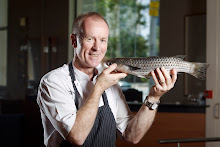 Blog followers will know that Barramundi is beyond a shadow of a doubt my favourite fish! I have blogged about it before and written recipes. I've been buying in fresh wild caught barra from North Queensland for my restaurant but we all know that given Australians ever increasing appetite for fresh fish, aquaculture barramundi is critically important in order to satisy demand. The value of the aquaculture industry in Queensland grew by almost 20% last year and is worth an estimated 102 million dollars in 2009-2010 to the Queensland economy.
Blog followers will know that Barramundi is beyond a shadow of a doubt my favourite fish! I have blogged about it before and written recipes. I've been buying in fresh wild caught barra from North Queensland for my restaurant but we all know that given Australians ever increasing appetite for fresh fish, aquaculture barramundi is critically important in order to satisy demand. The value of the aquaculture industry in Queensland grew by almost 20% last year and is worth an estimated 102 million dollars in 2009-2010 to the Queensland economy.Bluewater Barramundi raises its fish in the pristine waters of the Hinchinbrook Channel, a World Heritage listed area. This is Queensland’s only fish cage farm - the fish are raised from fingerlings swimming freely in large sea water cages their entire lives. This ensures that they have great muscle tone and texture.
Noosa River Smokehouse is doing a lovely smoked Bluewater barra product. It is cured, dried and hard wood smoked. Once smoked it's then vacuum packed and has a very good shelf life - 28 days. Owner Greg Rassmussen says: "A good smoked white fish is so versatile that anyone can make up a a classy meal with a few boiled spuds, cauliflower, parsley and bit of blue cheese. In terms of taste and texture the smoked Bluewater Barramundi beats the best white fish available".
Here's my recipe below but if you want to get some product from Noosa River Smokehouse head to Jan Power's farmers market at the Powerhouse on Saturday or in George Street the city on Wednesdays.
I've also added the fast and simple Barra recipe I often do at home with the family - prepared this last weekend at the Noosa Food and Wine Festival.
Poached Noosa River Smokehouse barramundi with poached egg and cheese sauce
Serves 6
Ingredients
6 x 150g cold smoked barramundi fillets
600ml milk
200ml cream
3 hard boiled eggs, chopped
2 tbs parsley, chopped
1 tbs chives, chopped
80g Gruyere cheese, grated
salt and pepper
6 soft poached eggs
100g unsalted butter
1 small onion, finely diced
1 stick celery, finely sliced
1/2 leek, finely sliced
1 carrot, peeled, finely diced
2 sprigs thyme
1 bay leaf
1 clove
55g plain flour
Method
Heat 50g butter in a non-stick pan on medium heat. Add onion, celery, leek, carrot, thyme, bay leaf and clove and sweat for 12 minutes until vegetables are soft. Add flour. Lower heat and cook out for 7 minutes, stirring occasionally. Place the barramundi and milk in a saucepan. Bring up to the boil and remove from heat. Remove barramundi from the milk after 6 minutes. Strain the milk onto the floured vegetables, stirring until the sauce is smooth. Fold in the cream. Fold in butter, chopped eggs, parsley, chives and half of the cheese. Heat until the cheese has melted. Check seasoning. Place barramundi into a lightly buttered shallow gratin dish. Place poached eggs on top and pour the sauce over. Sprinkle with remaining cheese and place under hot grill until golden. Remove and serve.
Grilled barramundi with hummus, herb salad and yoghurt
Serves 6
Ingredients
1/3 cup mint leaves
1/3 cup coriander leaves
1/3 cup flat-leaf parsley leaves
1 cup baby spinach leaves
1 tsp white wine vinegar
1 tbs extra virgin olive oil
1 tbs sea salt mixed with 1 tsp ground cumin
6 x 150g barramundi fillets (with skin on)
6 lemon wedges
Hummus
200g cooked chickpeas
60ml lemon juice
2 tsp ground cumin
50ml extra virgin olive oil
4 garlic cloves, chopped
150g tahini
1/2 tsp paprika
Dressing
300g Greek-style yoghurt
1 tbs chopped mint
1 tbs chopped basil
Method
For the hummus, blend chickpeas, lemon, cumin, oil, garlic, tahini and paprika in a blender until smooth. Season with salt and pepper. Set aside. For the dressing, combine yoghurt, mint, basil and 1 teaspoon salt in a bowl. Set aside. Place mint, coriander, parsley, spinach, vinegar and 2 teaspoons oil in a bowl and toss to combine. Preheat a heavy-based or non-stick frypan. Add the remaining 2 teaspoons oil. Sprinkle cumin mixture over fish, then place in the pan, skin-side down and cook for 4 minutes on each side. Divide hummus among 6 plates. Place barramundi on top. Spoon yoghurt onto barramundi and top with salad, then garnish with lemon wedges and serve.
Bluewater Barramundi http://bluewaterbarramundi.com.au/
Want to know more about sea cage aquaculture and its environmental credentials visit Australian Institute of Marine Sciences http://www.aims.gov.au/seacage-aquacultureFor more information about the barramundi farming industry visit the Australian Barramundi Farmers Association www.abfa.org.au/






